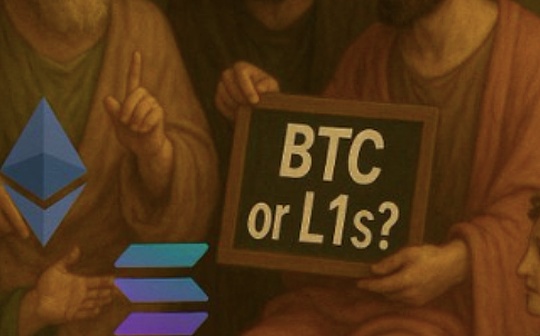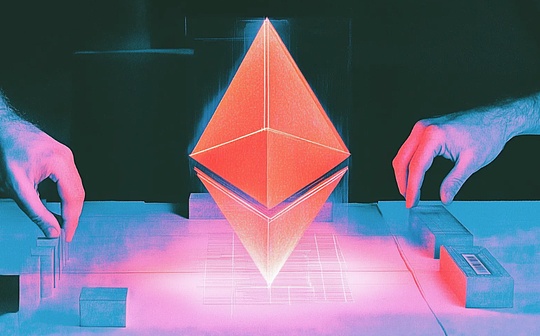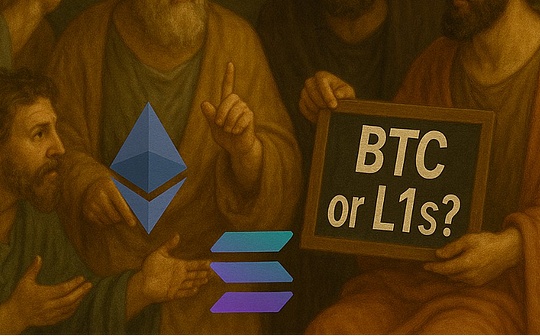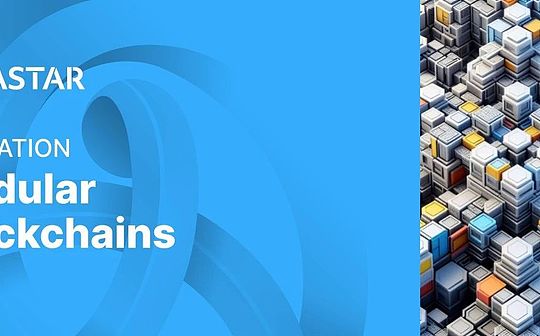
Last year, Celestia announced its ambition,Modular blockchainBecome a topic of extensive discussion.Since then, the theory of modularization has become popular.Thanks to the booming L2 ecosystem, countless data availability layers have been launched one after another.
However, the concept of modular blockchain is not brand new, nor is Celestia study.This article will introduceThe differences between the single blockchain and the modular blockchain, and how the ASTAR network is integrated into itEssence
Most so-called Alt-L1s are single chains.
What is a single chain?
The single chain combines all core functions of the blockchain.Although consensus is the most controversial topic when Alt L1 starts, the discussion has been transferred to different layers.
Blockchain has four core responsibilities:
-
consensus:The validity of the state conversion in a decentralized node network is consistent
-
implement:Actual handling of transactions submitted by users and smart contracts
-
Settlement:It usually occurs at the same time as the execution in the modular chain.The settlement transaction is considered to be the ultimate, because the chain is very likely.
-
Data usability:A often praised feature of blockchain is transparency.Data usability is the function of realizing this point. It provides all the data required to rebuild the history of transactions and verify the current status of the network.
In a single chain like Bitcoin and Ethereum, the same group of verifications handle all the above functions.This usually automatically limits the number of people who can run verifications, because the calculation requirements will increase with the use of the network.Today, the Ethereum archive node stores more than 10 TB data, which is not the storage ability on your mobile phone.Similarly, the calculation requirements for Bitcoin miners are very high, especially when competing for mining rewards.
In order not to exhaust hardware resources and reduce the degree of decentralization, the new expansion plan is focusing on decomposition tasks.
Modular blockchain
In simple terms,The modular blockchain is a blockchain that is dedicated to one or two blockchain core functions, and leaves other functions to developers built on it.This means that modular blockchain like Celestia or Avail only focuses on data availability and puts other functions.
>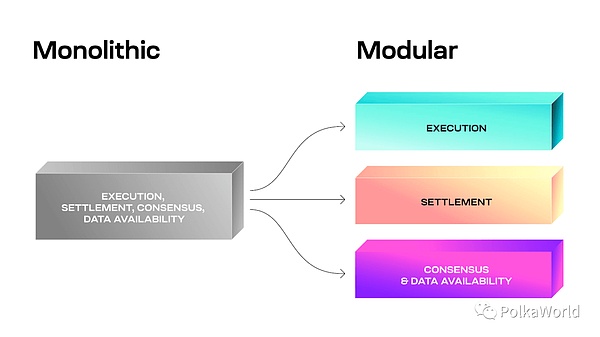
Source: CELESTIA blog
Background information: Ethereum expansion and demand for cheap DA
At first glance, we may not know what the modularization is, but if we understandThe evolution history of Ethereum expansionIt is not difficult to understand.
Ethereum’s original expansion vision isSectionThis means that the entire network is divided into different small blockchains.However, this will require major changes to the blockchain. This is why the roadmap has turned toLayer-2 (No. 2) expansionEssence
Layer-2 expansion can increase the throughput of the underlying chain by moving the transaction out of Layer-1, and submitting the results of batch transactions.This year, Layer-2 increased the overall throughput of Ethereum by more than 5 times.However, as active L2 users may have noticed, this does not necessarily mean that they can maintain low costs.During the high traffic period, the recently launched Linea network’s costs soared to $ 0.87, which seemed to be acceptable for the DEFI enthusiasts, but it was not in the context of large -scale adoption.
One reason for the soaring cost is that prices will be adjusted naturally during high demand periods and mechanisms to prevent junk transactions.However, the cost is usually driven by these Layer-2 when the data is released to Layer-Ethereum.
Layer 2’s operating costs are more likely90%RelyThe cost of publishing transaction data to the main networkComposition.Even if Protodanksharding is finally introduced and provided additional storage for L2 data in Blobs, the cost will still be quite high.
Introduce modular
Layer-2 needs to publish its transaction data so that anyone can verify its status and ensure that the transaction is legal.However, they do not need to use the Ethereum main network to achieve data availability.Instead, the Rollow and L2 expansion solutions operators can significantly reduce the cost by using solutions such as Celestia, Avail or Eigenlayerda, which usually have significantly reduced storage costs.
The benefits of reducing the cost of data release will be passed to users, creating a better overall experience for DAPP.Although data availability may be the most optimized part of the current Rollup in all stacks, Rollup itself is just a modular blockchain specialized in execution.
The overall thought of modular blockchain is,Instead of imposing various core functions on the same group of machines, it is better to allocate tasks and specialize in multiple layers (layers) to serve specific tasks to serve specific tasksEssenceThis also allows developers to create the most suitable multi -layer combination.Just like using Lego bricks, they can combine the cheapest DA, execute layers focusing on FUELVM, and Ethereum security provided by EigenLayer’s re-Staking.This method reduces the cost of developing the entire chain from scratch, while providing a solution that depends on other network security rather than starting its own.
In short, the benefits of modularity include reducing the costs and time of the development and launch of new chain, providing the flexibility that the single chain cannot compare, and scalability.
As mentioned earlier, despite this, modularization is not entirely new.Since its advent, it has been part of the narrative of application chain ecosystems like Polkadot and COSMOS.Both have established a modular framework that allows the chain to choose different modules and combine it to meet their needs.
This is the same as the ASTAR network.
So how does ASTAR do?
Astar Network was initially started as a parallel chain on PolkadotIt created a smart contract center that other parallel chains could use this ecosystem.Therefore, everyone may think that it is a single chain, but because it is part of the Polkadot ecosystem, the situation is a bit different.In essence,Boarded on Polkadot, the security guarantee that allows parallel chains to inherit the underlying chain, so that it is similar to the current modular chainEssenceThe relay chain is responsible for security and consensus, and developers on the parallel chain can focus on their unique advantages.
As one of the most successful parallel chains, Astar Network supports the welcomed builders of the community by establishing the DAPP pledge mechanism.Recently, Astar cooperated with Polygon to expand to the Ethereum ecosystem through ZKEVM L2.
At the same time, we are still embracing the modular narrative, and we have obtained the experience of using the modular framework construction in the past two years.
Outlook on the modular chain
The future of the blockchain is modular.Although there is still a place for the single chain that has been implemented or found its own market segment, there are more and more signs that we will modify it in the future.
Although everyone is very excited and looking forward to “superimposed different technical layers (similar to multi -layer cakes)”,There are still some challenges that need to be resolved in the modular blockchainEssence
In the modular paradigm,Security depends to a large extent on the bottomEssenceDevelopers will have to choose cautiously to avoid encountering a layer of failure that causes other layers to interrupt.This is like forgetting the bottom of the biscuits of black forest cake (so that the entire cake will collapse …).
In addition, although optimizing each layer can produce a better experience than each part, the cost isIncrease complexityEssenceTo handle fraud or validity proof to ensure that the calculation of other layers is correct, this is challenging.
Not to mention, modular blockchainFurther introduced fragmentation in the fragmented L2 ecological map sceneEssenceIn order to make the modular paradigm success, it will have to invest a lot of work on the user layer.In the final analysis, it is unlikely that users are consistent with Ethereum, and they don’t want to spend 50 minutes to understand what “inheritance security” means.
>
Nevertheless, with the rapid improvement of technology, and the overall focus shift to consumers to provide services to consumers through consumer -level applications, modular blockchain will definitely play a role in promoting adoption.

